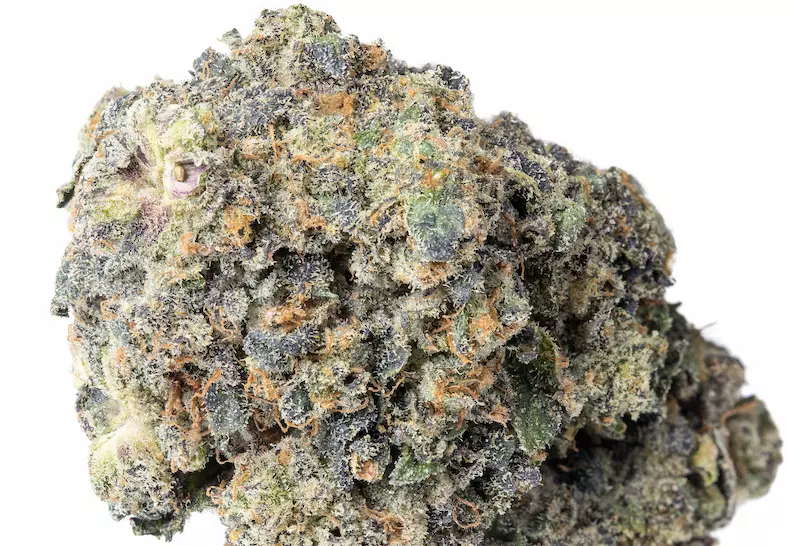If you’re not already familiar with the Japanese dessert mochi, consider this the time to get introduced. The dessert mochi is a chewy Japanese confection made of rice flour. It comes in a wide assortment of different flavors that typically include matcha, vanilla and chocolate. Some versions of the dessert use mochi to create ice cream, making mochi a popular frozen dessert, too. The strain Mochi, on the other hand, isn’t actually edible, but contains many of the same scents and flavors that the dessert does.
Mochi was introduced to the cannabis world by the legendary cannabis breeder Mario Guzman, a.k.a. Mr. Sherbinksi. The San Francisco-based grower was already notorious for bringing famed strains to market, including Pink Panties and Sunset Sherbet.
Sherbinksi crossed a Sunset Sherbet and Thin Mint Girl Scout Cookies plant to yield Gelato, a dessert strain known for its sweet flavor profile. As is typical with members of the Cookie family, excited consumers inspired growers to experiment with–and generate–several phenotypes of this plant. Mochi 47, or the 47th phenotype, proved to be one of the most popular. The strain is sometimes also known as Mochi Gelato or Gelato 47.
Mochi Strain Effects: Indica or Sativa?
Two Cookie-based parents make this a very well-balanced hybrid strain that possesses both cerebral and physical effects. On one side we have Girl Scout Cookies (GSC), one of the most beloved classic strains of all time. GSC is the child of Durban Poison and OG Kush parents. Durban Poison is a potent sativa, and OG Kush is a powerful indica, making GSC a heavy hitter with respect to both categories of cannabis. The Thin Mint strain is a subtype of GSC with the same genetics.

Durban Poison is a landrace strain known for its mentally stimulating and highly creative properties. It’s earned a reputation as one of the best kinds of cannabis to hit you with a lightning bolt of inspiration, and is also an excellent option for social gatherings as it can encourage the giggles, productivity or chattiness. Some consumers have also reported sensory distortions and describe the experience as psychoactive-like.
OG Kush, on the other hand, is known for its characteristic ‘heaviness’. It produces a sedating state that takes over the body with a powerful high, gluing consumers to the couch. The high can feel stony or opiate-like, and is best consumed at nighttime before bed.
Mochi shares the characteristics of both parents. Its initial stages produce a powerful onset of creativity and cerebral energy that’s great for focusing on detailed tasks like making art. This can quickly segue into physical relaxation that manifests as a heavy body high that can feel immobilizing. Muscles begin to relax as tension and pain melt away. Couch lock may take over, leaving users sleepy and ready to hit the hay.
Medical users report Mochi helps them manage several conditions including ADHD, depression, stress, anxiety, loss of appetite and insomnia. Mochi is said to have anti-inflammatory properties that may provide relief from chronic conditions such as diabetes or lupus. Beginners should also be wary when consuming as this strain’s powerful psychoactive punch can induce paranoia in those with a low tolerance to THC. Other side effects reported with this strain include dry mouth/thirst, slurred speech and the munchies.
Mochi Strain Terpene Profile and Characteristics
This is a strain that absolutely nails the bag appeal category. Mochi’s leaves are large but compact, with tight buds forming a conical shape. The color of the leaves, however, is really what draws the eye in. Buds are often purple or may appear to have a blue-ish hue. This is the result of anthocyanin pigments that develop during exposure to cold in a plant’s vegetative state. They can also take on rich, deep green hues. Pistils are orange and red in high contrast against the purple, and are covered in silvery trichomes.
If cured properly, Mochi’s scent evokes a particular type of sweet: sugary confections. Initial impressions fill the nose with sweet vanilla and a gentle floral quality reminiscent of potpourri, matcha or a bouquet of flowers. The second most distinct aroma is that of mint, a scent inherited from the Girl Scout parent. Mochi’s got a sweet but minty fresh taste just like the cookie its namesake was derived from. Breaking apart Mochi buds yields a more toasted odor which pivots back to sweet when smoking. The final note is clean mint with spicy floral elements lingering in the background.
Some lab reports document Mochi as a cannabinoid rich strain. Other cannabinoids beyond THC found in Mochi include cannabigerol (CBG), cannabidiol (CBD) and tetrahydrocannabivarin (THCV), although these ‘minor cannabinoids’ are found in relatively low concentrations.
In terms of terpene content Mochi’s primary terpenes are typically myrcene, pinene, caryophyllene and limonene — terpenes common to the Cookie family. Some Mochi strains are also said to contain linalool, geraniol and bisabolol, with minor terpenes including pulegone and terpineol.
Mochi Strain Seeds and Grow Info
This strain is moderately difficult to cultivate but can be grown in or outdoors. It’s known to grow short and bushy, with robust lateral branching patterns and an overall dense internal structure. A hot, humid climate is recommended for outdoor growth. Growers hoping to develop the rich purple and blue hues characteristic of anthocyanin pigments will want to expose Mochi to the cold (temperatures between 55 and 65 degrees) shortly before flowering begins, around week 9. Overall flowering time is 9-10 weeks, with ideal harvesting time at the end of September/early October.
Unfortunately for most growers, Mochi is a clone-only strain, meaning you can’t cultivate or buy it in seed form online. Aspiring growers will need to obtain clippings they can then cultivate as clones if they want to get their hands on Mochi’s tantalizing taste.
By Janelle Lassalle
Artist, Writer, and Content Creator
@jenkhari
